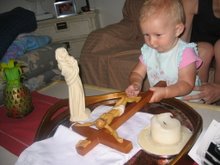
Our Life
Weather in Hawaii. Mary and I have lived in Hawaii off and on now for almost two years. It has taken us some time to get used to the weather. For all those who don't live in Hawaii, here is the story. Hawaii has two major seasons: the wet season and the dry season. The wet season is characterized by a lot of rain and lasts from approximately October to April. The dry season doesn't get as much rain and lasts from June to September. The rain tends to come from the windward side of the island, or the eastern side, and sweeps to the west. Since we live in Manoa Valley, a borough of Honolulu, the rain comes down the mountains behind our house and heads out to sea. Hawaii is the wettest place on earth. The island of Kauai receives the most rainfall in the world. We took a family vacation in Kauai in December of 2006. It's a beautiful island. (Fortunately, we had good weather while we were there.) Due to the rain intensity, it's not uncommon to see different rain patches throughout the valley. One can identify three different precipitation patterns occurring simultaneously in various sections of the valley. I remember taking a run from our house to Waikiki. In a relatively short distance, I passed through two wet and two dry regions. Flooding is a concern for the islands.
The trade winds present another interesting facet. Trade winds flow from the northeast and typically correspond with the wet period. The cool gusts of wind keep the islands a bit cooler during the winter period. Nothing too cold. Mainly 60s or 70s. Always pleasant. The strong wind has one major downside: it's hard to talk on cellphones outside. I enjoy talking to my family and friends when I am walking from one place to another. The gusts make it tough to be understood.
One last cool tidbit. Hawaii is known as the rainbow state. Rainbows emblazon the state's licence plates. With the frequent sun and rain, we have witnessed some spectacular rainbows in the valley. Sometimes, I have seen 2 or 3 rainbows arching over one another. It's a gorgeous sight that I doubt I will ever experience again in my lifetime. The University of Hawaii female athletes are called the Rainbows. Vicious, huh? Watch out. Supposedly the men went by the same name till they recently switched to the Warriors. I guess that's a bit more aggressive-sounding.
Current Affairs Commentary
The Catholic Church and Immigration in the United States. The recent immigration bill in the US, like any immigration policy, is very polarizing. While partisan politics expresses some unison in the illegal immigration debate, there seems to be little consensus within major political parties.
I think that the media does a fine job of skewing the Catholic Church's position on many issues, immigration being one of them. The Church has been so wise, in my opinion, to steer clear of endorsing specific political or economic systems, policies, and politicians. I don't say that because I believe the Church shouldn't involve itself in the public sphere. Rather, the Church shows its wisdom by adhering to sound principles that should underlie just systems, policies, and platforms. Systems, policies, and platforms naturally evolve over time. The short history of the US illustrates how our two parties have switched platforms a couple of times. Capitalism and socialism come in so many shades. Policies and laws depend on judicial interpretation and implementation to be successful. For that reason, the media takes it upon itself to apply the principles of the Church to specific situations. It is the role of the individual believer, with the help of the magisterium, to apply these principles. It is not the role of the media.
Anyhow, back to illegal immigration. What is the Church's stand? This is new field for me. I am familiar with basic Church teachings on the dignity of the human person, but I am not familiar with specific Church immigration documents. Quoting from a Migration Information article, "In Strangers No Longer, the church states that people have the right not to migrate; that is, they should be able to live freely in their countries of birth. However, when this is impossible, whether due to extreme poverty or persecution, the church says they have a right to migrate, and nations have a duty to receive them." As such, nations should receive immigrants from countries riddled with extreme poverty and persecution. However, the Catholic Church does NOT support open borders, illegal immigration, or an "amnesty" that would confer a legal status on illegal immigrants. Nevertheless, the Church believes that all humans, despite their country of origin, deserve to be treated with dignity and respect. Cardinal Mahoney of Los Angeles, CA, recently emphasized this point by instructing his diocese to still provide humanitarian and religious services for illegal immigrants in the United States. It is not the position of the Church to establish US legal immigration quota, just like it's not the position of the Church to request the legal status of the people it serves.
Quick Thoughts on Today's Gospel

Readings Today -- [T]hat they may be one, as we are one, I in them, and you in me.
"We believe in one, holy, Catholic and apostolic Church" (emphasis mine). God wants us to be one body, one Church in him. He wants us to be united to him, as branches to a vine. For, connected to Christ, we are connected to the trinity and the God head. The ecumenical movement strives to bring all believers into the one body of Christ. It's hard to understand and grasp. Hundreds of years of religious enmities and religious wars, coupled with violence even today, checkers interreligous dialogue and debate. Within the Christian religion alone, new denominations are springing up like mushrooms. It appears rather difficult to bring all believers into a single body. Yet, Christ is calling us to unity. Many Catholics and members of other faiths are skeptical of ecumenism. They have some reason to be since ecumenism is easily confused with religious relativism. Nevertheless, following the example of John Paul II and Benedict XVI, we should challenge ourselves to engage in ecumenism in our own small way. How many friends do we have of other faiths? How often have we reached out to them to understand them and dispel their misunderstandings of our faith? I doubt that we will achieve the ideals set out in ecumenism during our lifetime, but we can still do our part to continue Christ's mission on earth.









